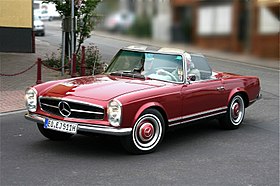| Mercedes-Benz W113 230 SL, 250 SL, 280 SL | |
|---|---|
 | |
| Overview | |
| Manufacturer | Daimler-Benz |
| Production | 1963–1971 48,912 built[1] |
| Assembly | West Germany: Stuttgart Sindelfingen |
| Designer | Friedrich Geiger Béla Barényi Paul Bracq |
| Body and chassis | |
| Class | Sports car / Grand tourer |
| Body style | 2-door coupé 2-door roadster |
| Layout | Longitudinal FR layout |
| Platform | Mercedes-Benz W111 |
| Related | Mercedes-Benz W108 Mercedes-Benz W109 Mercedes-Benz W112 |
| Powertrain | |
| Engine | |
| Transmission | 4-speed automatic 4-speed manual 5-speed ZF S5-20 manual |
| Dimensions | |
| Wheelbase | 2,400 mm (94.5 in) |
| Length | 4,335 mm (170.7 in) |
| Width | 1,760 mm (69.3 in) |
| Height | 1,305 mm (51.4 in) |
| Curb weight | 1,300 kg (2,866 lb) |
| Chronology | |
| Predecessor | Mercedes-Benz W198 Mercedes-Benz W121 BII |
| Successor | Mercedes-Benz R107 |
- See Mercedes-Benz SL-Class for a complete overview of all SL-Class models.
The Mercedes-Benz W 113 is a two-seat roadster/coupé, introduced at the 1963 Geneva Motor Show and produced from 1963 through 1971. It replaced both the 300 SL (W 198) and the 190 SL (W 121 BII). Of the 48,912 W 113 SLs produced, 19,440 were sold in the US.
The W 113 SL was developed under the auspices of Mercedes-Benz Technical Director Fritz Nallinger, Chief Engineer Rudolf Uhlenhaut and Head of Styling Friedrich Geiger, who had previously designed the iconic 500K/540K and 300 SL. The lead designers were Paul Bracq and Béla Barényi, who created its patented,[2] slightly concave hardtop, which inspired the "Pagoda" nickname.
All models were equipped with an inline-six engine with multi-port fuel injection. The bonnet, boot lid, door skins and tonneau cover were made of aluminium to reduce weight. The comparatively short and wide chassis, combined with an excellent suspension, powerful brakes and radial tires gave the W 113 superb handling for its time.[citation needed] The styling of the front, with its characteristic upright Bosch "fishbowl" headlights and simple chrome grille, dominated by the large three-pointed star in the nose panel, paid homage to the 300 SL roadster.
W 113 SLs were typically configured as a "Coupé/Roadster" with a soft-top and an optional removable hardtop. A 2+2 was introduced with the 250 SL "California Coupé," which had a fold-down rear bench seat instead of the soft-top.
- ^ Oswald, Werner (2001). Deutsche Autos 1945-1990, Band 4. Stuttgart: Motorbuch Verlag. ISBN 978-3-613-02131-0.
- ^ US patent 3169793, Béla Barényi & Paul Bracq, "Motor vehicle with a concave top", issued 1965-02-16, assigned to Daimler-Benz Aktiengesellschaft=